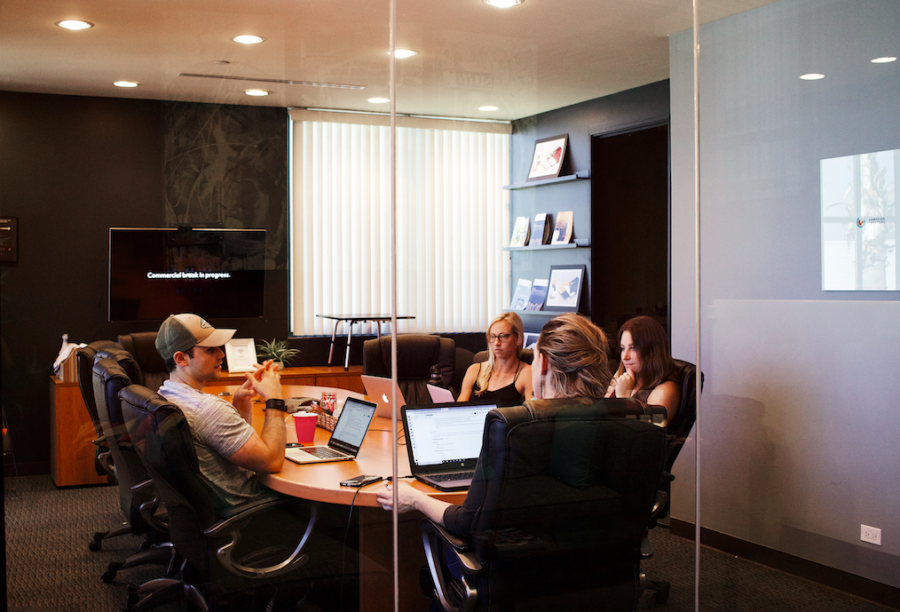Holding meetings is part and parcel of professional life. In almost every industry, there is some element of collaboration, and good communication is an essential pillar of teamwork. While there are lots of business communication tools to keep your team connected, meetings will always be a crucial aspect of business. And yet, though meetings are really the bread and butter of our working lives, they often fill us with dread. They can feel dull, unproductive, time-consuming, and sometimes even hostile.
The fact is, many people – including employers – don’t really know how to hold business meeting. If your meetings are making employees feel deflated, discouraged or dismissed, it could impact morale. To make sure meetings are positive and productive, follow our guide to successful business meetings!
Before the business meeting
Yes, one of the oldest of chestnuts. But preparedness is an oft-repeated piece of advice for good reason. If attendees don’t know the expectations and objective of the meeting beforehand, how can they deliver?
So even before you start to think about when to have your meeting, or who you want to invite, you should dedicate some thought to the meeting’s purpose. Keep the focus narrow to make sure you stay on-topic, as this is one of the key ingredients in how to hold business meetings.
What’s the point of the business meeting?
By picking one specific target and topic, you’ll also be able to think carefully about who you invite. Who is actually involved in the project in question? Which team members can contribute to the conversation? Who needs to be fully informed of what’s going on? If there are people who would benefit from knowing the general gist of happenings in the business, but have no direct contribution to make to the meeting, they might not need to be there. Instead, you could consider offering them the option to see the agenda and the minutes before and after the meeting, so they’re more or less up to speed. That way, you avoid having people in attendance who are bored, frustrated, and could be better using their time.
Agendas are a key component of successful business meetings
Once you’ve sketched out the purpose and the participants, you should nail down an agenda. Don’t just have an idea of what you hope to cover in the meeting. Sit down and write or type the objectives, and make a list of what needs to be discussed and achieved to reach the goal. Then look at your list, and think about the most logical way to arrange it into talking points.
Aside from an ordered list of talking points, it can be helpful to point up exactly who each area might relate to, and what you hope they’ll be able to bring to the meeting, and the project more broadly.
With these general points sorted, you can start to consider how much time each section and each participant will need. When you’re allotting time, be very mindful of not giving yourself too much. For some, possibly new, leaders who are unsure of how to hold business meetings, falling into a lecture-style speech is a dangerous pitfall. The point of a meeting is collaboration and conversation, so don’t just sit and talk at your participants. Giving a broad introduction laying out the plan for the meeting and why you’ve called it can be useful, but after that you should generally be aiming for a discussion rather than a sermon.
For a successful business meeting, everybody should see the agenda
Now you have a detailed document laying out who will be talking about what, when, and for how long, you should circulate it. It’s no use you being the only one who knows the plan – that would be like walking onto a set and being the only actor who’s seen the script. If you’re holding a teleconference (and maybe you should be – conference calling has lots of benefits for businesses), you could share these alongside the access details. Alternatively, you could attach it to a polite reminder of the business meeting time, and an invitation for any of the participants to suggest amendments or additional topics they’d like to cover.
Location, location, location
As well as deciding what the meeting is for and who should be participating, you need to think about where you want to hold it. If you’re part of the ever-growing number of people who are adopting flexible working, you might not have an official office space that you can access whenever you need, or for large meetings. If you’re looking to save money, there are lots of great free meeting locations to consider.
Or you could make your business more environmentally friendly as well as freeing up some of your company’s budget by having a conference call instead of a physical meeting.
When you’re picking a place, do consider your employees or other attendees. Try to choose somewhere relatively central, that is well-connected to public transport from different areas, if people won’t all be coming from the same place. If you can, opt for somewhere that’s easy to find and identify, too. People will arrive late, stressed and frazzled if your meeting is taking place somewhere a bit too obscure or tricky to find! You should also consider the noisiness or general appropriateness of your surroundings. Depending on your needs, the technology available might also be an important factor.
During the business meeting
Manners matter
Like preparedness, politeness might seem like an obvious suggestion. But it’s absolutely critical to successful business meetings. Make sure you don’t interrupt anybody, and don’t allow anybody else to, either. If interruptions happen, always try to return to what the initial speaker was saying. Give them the opportunity to finish their thought. Be careful not to ignore anything somebody says, too. It’s better to ask them to repeat themselves if you’re not sure you’ve heard, than to let them think their ideas don’t matter.
Even before any potential for cross-talk, you should dedicate time to introductions and even some small talk. Let people get relaxed and settled before diving into anything official or complicated.
And like in any conversation – particularly one with multiple participants – you really shouldn’t be doing 80% of the talking. If you’ve properly planned your agenda, this should be an easy pitfall to avoid. Stick to your script, and be willing to defer to people even when you might have planned on doing the talking. After all, you already know what you think. You’ll likely gain more from talking than listening, and your attendees will feel that their time and contributions are valued.
Stick to the script of a successful business meeting
You spent time making and circulating an agenda, so don’t forget about it once the meeting starts! Keep it in eyesight, and follow the points to make sure you’re not off-topic. You also need to watch the time. Don’t let certain sections take longer than you’d planned if you can avoid it. Otherwise, you’ll either overrun, which is poor etiquette and unfair on attendees, or you’ll have to call another meeting. Both make extra demands on attendees’ time, and will lead to frustration. Plus, if you dedicate too much time to one area, everybody not involved in that area will be twiddling their thumbs, waiting to join in a meeting you invited them to.
Don’t change the order
Avoid jumping around different points out of order, too. This can produce anxiety for people who might have planned what to say and how they’ll link it to other ideas. But it can also be really confusing. Sure, you know all about the topics being discussed. Remember that not everybody does, though. Your agenda will have been planned to cover things in a coherent order, with one point following logically from the rest. This allows everybody to follow what’s happening, even if they aren’t experts on every point. If you deviate from the order, some people might quickly become lost and feel unable to join in for the rest of the meeting. Haphazardly and confusingly is certainly not how to hold a business meeting.
Keep people engaged
Yes, having a rigid agenda can feel boring and stiff. But it’s your job to make sure that everybody is interested and alert. That means you need to plan a varied, dynamic meeting. Identify factors that can kill productivity in business meetings beforehand. That way, you can eliminate them before they become a problem. And just as you shouldn’t stand and talk endlessly, you definitely shouldn’t fall back on a predictable presentation. It’s 2019, and an endless Powerpoint will send your business meeting attendees to sleep.
Don’t let anybody leave the business meeting with uncertainties
As you wrap up the meeting, you should always open up the floor for general questions, clarifications and comments. Try to do this in an open-ended way, rather than simply asking something like ‘does everybody understand what to do next?’ or ‘did all of that make sense?’. While these kinds of questions might be well-intentioned, it can be difficult to say no. Instead, you might say ‘can anybody think of anything we’ve not covered?’, ‘does anyone have any other thoughts?’ or just ‘are there any questions?’. That way, there isn’t any connotation of judgement or failure attached to piping up.
After the business meeting
Memory is fallible. Minutes are divine.
Just as you shared your plans with everybody, you should also share the results. Circulate the meeting minutes to everybody who attended, and anybody who might have been unable to, or who might gain from knowing what happened even if they had no direct contribution to make.
Even better, if you opted for a virtual meeting and made the wise choice of recording the conference call, you could share the recording alongside the minutes. Of course, you might not feel you need to do this, as thanks to call recording you can make accurate and detailed minutes after the meeting, to make sure everyone is fully engaged and attentive during.
Nobody can identify a successful business meeting like its participants
Who better understands if the meeting went well or not than the people who were there? Just as your attendees are invaluable assets with wonderful ideas to contribute to your company, they are also the best resources to understand what’s working and what isn’t in the way you conduct business meetings. So ask for feedback!
When you send out the meeting minutes and summary of what was achieved and next steps, you could ask participants how they feel the meeting went. How you do this is up to you. You could attach a questionnaire or survey. Another option is to ask for a numerical ranking. Or keep it simple, and just ask for their opinions and suggestions directly. However you choose to do it, you could gain a lot of insight into things you might not even know you were doing, or should have been doing, by asking the people most affected.
Schedule a follow-up business meeting
Good communication isn’t a one off, it’s a pivotal component of keeping your business running day to day. Whether your team works remotely or share office space, you should be actively dedicating time to getting together and discussing progress and ideas regularly. This might seem easier if you do all work in the same space. Then it can often be as simple as agreeing to have your Monday morning coffee in the common area. Remote workers can sometimes have more varied schedules, as a lot of people choose flexible working in order to rebalance their personal and professional lives. That can mean that during traditional working hours, a parent might be with their infant, and then completing their work in the early morning and evening.
But by keeping meetings regular and brief, and ensuring that only the people who need to attend each do, you can probably find a time that suits all members of the specific team. And thanks to things like WHYPAY?’s teleconference scheduling feature, you can easily plan recurring calls and have them immediately input into participants’ calendars. That way, the busiest, most haphazard schedule won’t stop anybody from attending the call and missing the business meeting.




